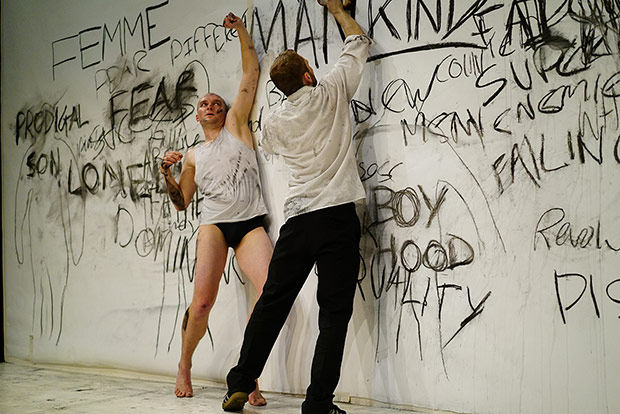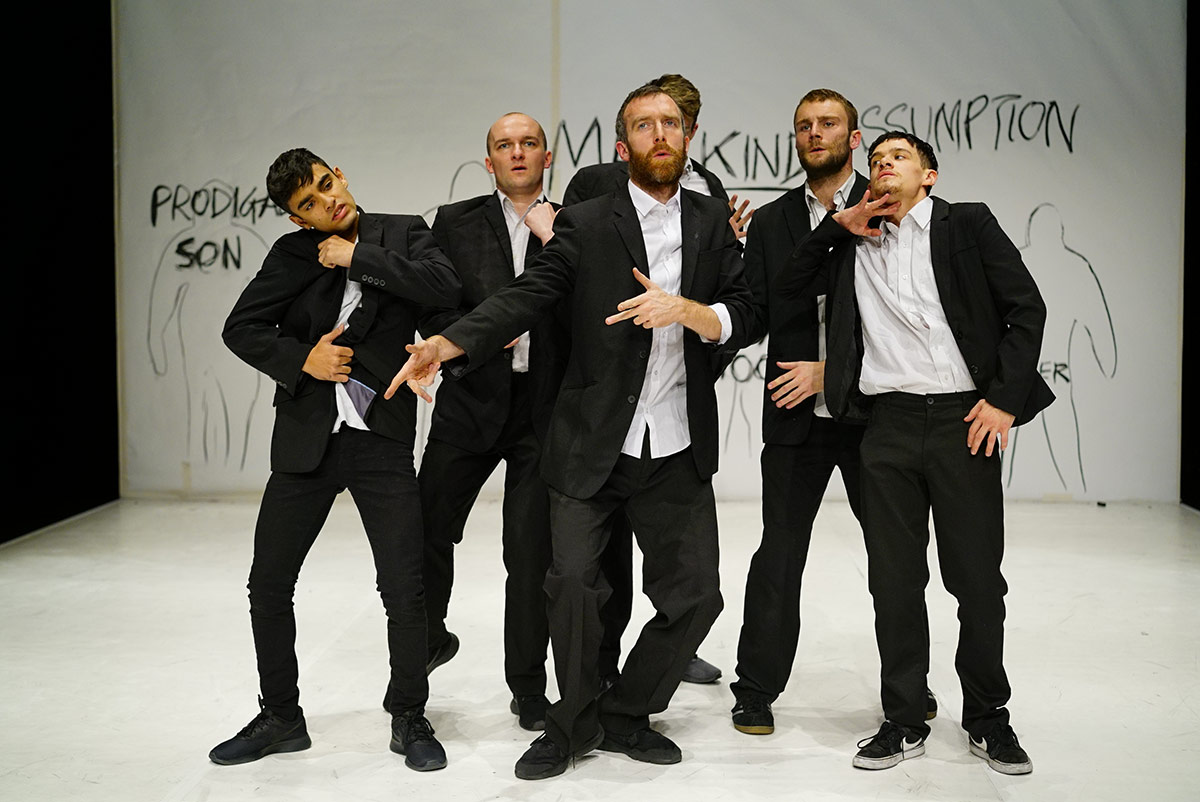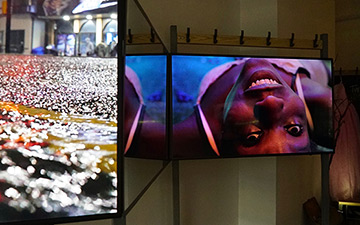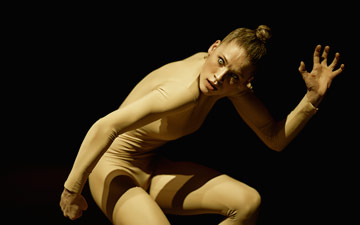
© Bosie Vincent. (Click image for larger version)
Vincent Dance Theatre
Shut Down
★★★✰✰
London, The Place
28 November 2017
www.vincentdt.com
www.theplace.org.uk
Shut Down is a hard-hitting work about men. Actually white privileged men. It portrays a bleak landscape of absent fathers, depressed teenagers and confused blokes. Shut Down feels (intentionally) unfinished, raw and blurry. It doesn’t offer solutions to the current crisis of masculinity but through rap- poetry, text, gestural movement and dance, Charlotte Vincent’s new work transmits powerful messages and poses challenging questions. What happened to the promises of the new man who cleaned, washed and dedicated himself to child-care? Where are dads when they’re needed? Why can’t men cry in public or show their vulnerable sides more readily?
Vincent has assembled a courageous cast of adult and young male performers who are not afraid to act out some of the serious dilemmas of being a man. They stand up-close to the audience, a line of men with different histories but shared realities, carrying the burden of contemporary manhood. Their look is vulnerable, searching, defensive – there is little joy about them. Throughout the piece, they will scribble descriptions of how they feel about themselves or others on a huge sheet of paper on the back wall, whether it is ‘lonely’, ‘prodigal son’, ‘afraid’, ‘femme’, ‘wanker’.

© Bosie Vincent. (Click image for larger version)
Robert Clark plays the middle-class dad figure and is the principal speaker of the group. In a self-flagellatory monologue he lists the problems of maleness and calls for a man’s manifesto to re-address the imbalance of the sexes; to sort out the confusion implicit in having to operate within a limited range of stereotypes; how to deal with the violence, anger and loneliness that is now synonymous with male youth culture and that men have to work with younger generations to improve the drastic situation. His tone is faltering and his presence insecure as he glances anxiously around at the rest of the cast. We feel his pain.
Shut Down for all its unanswered questions and projected images thrown chaotically onto the stage, has a tight structure. Repeated fragments of text and dance sequences frequently appear like choruses and provide a strong back-bone to the work when the subject matter gets tricky. For example, Clark’s statement “this is a piece about men”, or the ritualistic dance motifs containing boxing, jumping and turning as the men urgently run in a circle.
Individual solos communicate the various subjects of manhood: Jack Sergison plays the sensitive loner who is probably gay. The others make-fun of his ‘other’ ways or ignore him completely. Jake Evans acts the cross-dresser who is only happy when he puts on a pink, sparkly tulle ball gown. His solo in which he performs a range of gender identities is breathtakingly delicate, fluid and convincingly real and suggests a creative ‘third’ way of being a man, a blend of male and female. Janus Orlik portrays the man with a baby who is quiet, sensuous but ultimately passive and reminds us of how hard it is for men to show soft emotions in an Alpha male or macho climate.

© Bosie Vincent. (Click image for larger version)
From the group of teenagers, Markus Faulkner embodies a son who just wants his dad to play ruby with him. One of his solos, performed to some shmaltzy music on his mobile phone, brilliantly communicates a boy who is dying to dance but will only do so when no-one is watching. James Rye dances a sensitive hip hop solo alongside Clark’s commentary on what happens to boys whose teachers and fathers fail them. Both are riveting performers, a fascinating mix of dancer and awkward, hurt adolescent. Similarly Eben Roddis who raps poetically about absent fathers, having to ‘man up’ and the fragilities of the male ego, is equally mesmerising as a troubled teenager. While he doesn’t dance, his presence on stage is an integral part of the group.
In another section the men form a line downstage and fire off invisible guns or explosives at the audience. We all know about men’s obsession with killing but when they then crumple against the back wall sobbing and wailing, we see another side to it.
While the choreography is fused with hip hop, it’s not developed into the usual showy, virtuosic street dance. Like-wise Jules Maxwell’s music, composed with young people from AudioActive, is inventive, urban but refreshingly not mainstream. Vincent and the performers have devised collages of movement that reflect collective experiences of anger, stress and tension: torsos shudder and shake with pent-up emotion fused with violent hip hop gestures such as pulling a noose tight around the neck, giving the middle finger or punching with tight fists. It’s a unique, non-commercial style, which is very exciting in its visceral roughness.
For taking on such a difficult topic, Vincent and the dancers have clearly pushed way out of their comfort zones and need to be applauded. At times Shut Down is uncompromisingly stark and explicit in its depiction of masculinity and although some levity may appear in the danced sections, the general tone is heavy and fittingly unglamorous. Although the work could be pacier, shorter (it feels long at just under two hours) and a little more playful if it is going to speak to a wider audience of men and boys, its importance as a piece of political theatre is unquestionable.

















You must be logged in to post a comment.